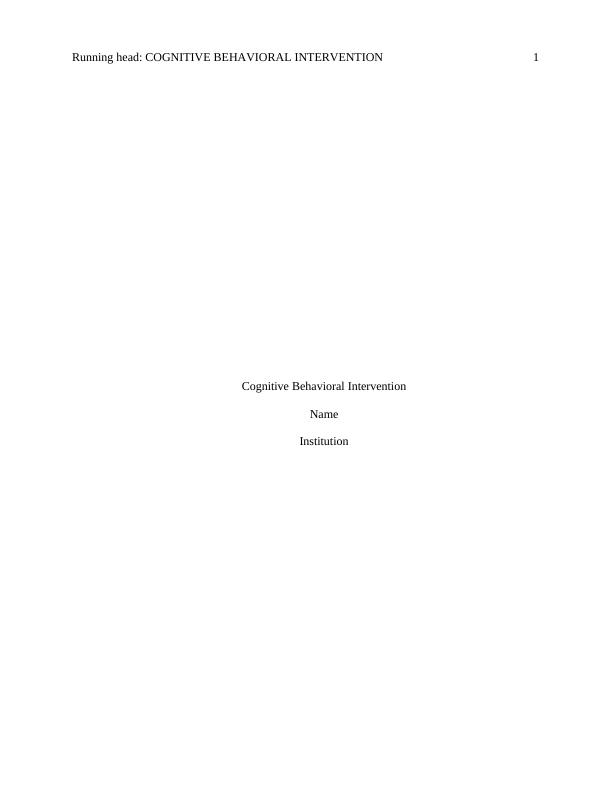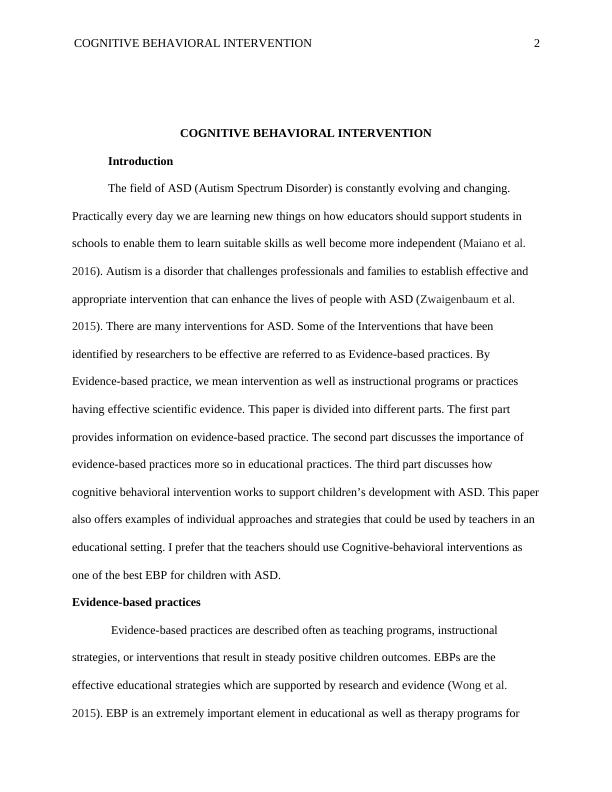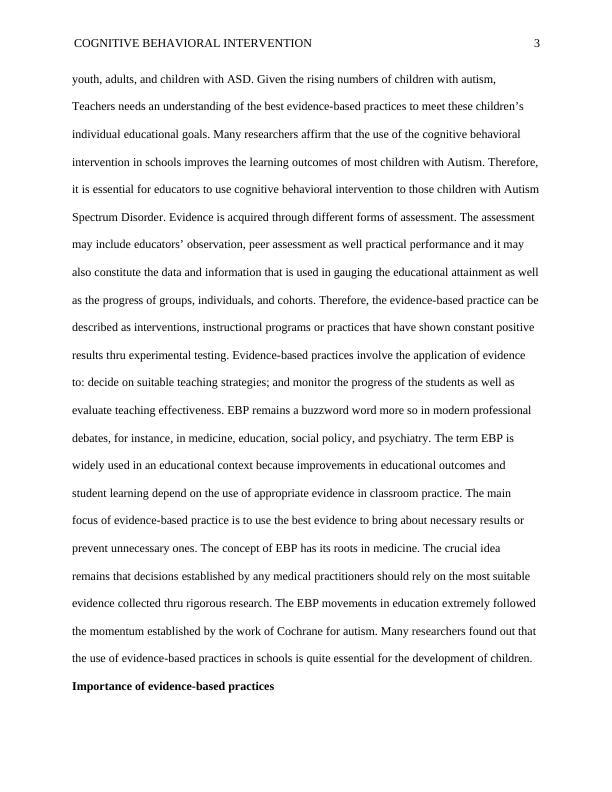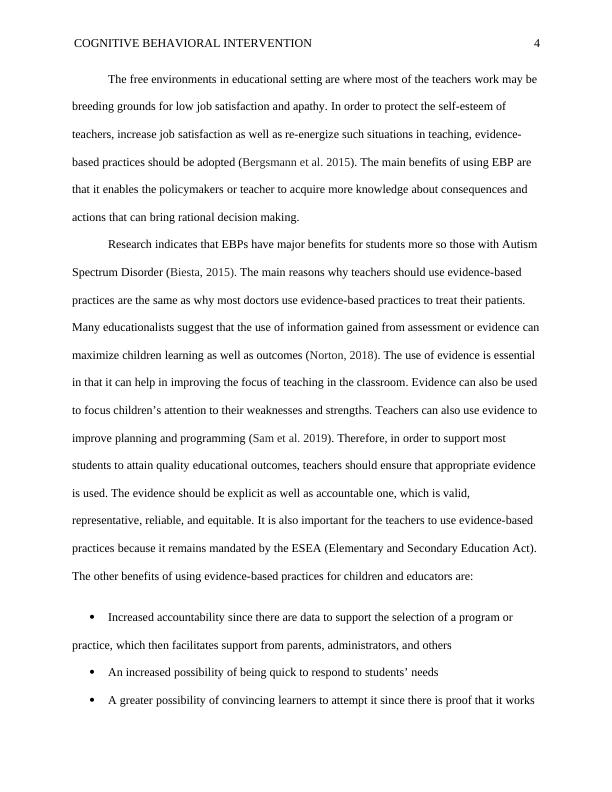Cognitive Behavioral Intervention for Children with Autism Spectrum Disorder
Added on 2023-01-05
11 Pages3048 Words96 Views
Running head: COGNITIVE BEHAVIORAL INTERVENTION 1
Cognitive Behavioral Intervention
Name
Institution
Cognitive Behavioral Intervention
Name
Institution

COGNITIVE BEHAVIORAL INTERVENTION 2
COGNITIVE BEHAVIORAL INTERVENTION
Introduction
The field of ASD (Autism Spectrum Disorder) is constantly evolving and changing.
Practically every day we are learning new things on how educators should support students in
schools to enable them to learn suitable skills as well become more independent (Maiano et al.
2016). Autism is a disorder that challenges professionals and families to establish effective and
appropriate intervention that can enhance the lives of people with ASD (Zwaigenbaum et al.
2015). There are many interventions for ASD. Some of the Interventions that have been
identified by researchers to be effective are referred to as Evidence-based practices. By
Evidence-based practice, we mean intervention as well as instructional programs or practices
having effective scientific evidence. This paper is divided into different parts. The first part
provides information on evidence-based practice. The second part discusses the importance of
evidence-based practices more so in educational practices. The third part discusses how
cognitive behavioral intervention works to support children’s development with ASD. This paper
also offers examples of individual approaches and strategies that could be used by teachers in an
educational setting. I prefer that the teachers should use Cognitive-behavioral interventions as
one of the best EBP for children with ASD.
Evidence-based practices
Evidence-based practices are described often as teaching programs, instructional
strategies, or interventions that result in steady positive children outcomes. EBPs are the
effective educational strategies which are supported by research and evidence (Wong et al.
2015). EBP is an extremely important element in educational as well as therapy programs for
COGNITIVE BEHAVIORAL INTERVENTION
Introduction
The field of ASD (Autism Spectrum Disorder) is constantly evolving and changing.
Practically every day we are learning new things on how educators should support students in
schools to enable them to learn suitable skills as well become more independent (Maiano et al.
2016). Autism is a disorder that challenges professionals and families to establish effective and
appropriate intervention that can enhance the lives of people with ASD (Zwaigenbaum et al.
2015). There are many interventions for ASD. Some of the Interventions that have been
identified by researchers to be effective are referred to as Evidence-based practices. By
Evidence-based practice, we mean intervention as well as instructional programs or practices
having effective scientific evidence. This paper is divided into different parts. The first part
provides information on evidence-based practice. The second part discusses the importance of
evidence-based practices more so in educational practices. The third part discusses how
cognitive behavioral intervention works to support children’s development with ASD. This paper
also offers examples of individual approaches and strategies that could be used by teachers in an
educational setting. I prefer that the teachers should use Cognitive-behavioral interventions as
one of the best EBP for children with ASD.
Evidence-based practices
Evidence-based practices are described often as teaching programs, instructional
strategies, or interventions that result in steady positive children outcomes. EBPs are the
effective educational strategies which are supported by research and evidence (Wong et al.
2015). EBP is an extremely important element in educational as well as therapy programs for

COGNITIVE BEHAVIORAL INTERVENTION 3
youth, adults, and children with ASD. Given the rising numbers of children with autism,
Teachers needs an understanding of the best evidence-based practices to meet these children’s
individual educational goals. Many researchers affirm that the use of the cognitive behavioral
intervention in schools improves the learning outcomes of most children with Autism. Therefore,
it is essential for educators to use cognitive behavioral intervention to those children with Autism
Spectrum Disorder. Evidence is acquired through different forms of assessment. The assessment
may include educators’ observation, peer assessment as well practical performance and it may
also constitute the data and information that is used in gauging the educational attainment as well
as the progress of groups, individuals, and cohorts. Therefore, the evidence-based practice can be
described as interventions, instructional programs or practices that have shown constant positive
results thru experimental testing. Evidence-based practices involve the application of evidence
to: decide on suitable teaching strategies; and monitor the progress of the students as well as
evaluate teaching effectiveness. EBP remains a buzzword word more so in modern professional
debates, for instance, in medicine, education, social policy, and psychiatry. The term EBP is
widely used in an educational context because improvements in educational outcomes and
student learning depend on the use of appropriate evidence in classroom practice. The main
focus of evidence-based practice is to use the best evidence to bring about necessary results or
prevent unnecessary ones. The concept of EBP has its roots in medicine. The crucial idea
remains that decisions established by any medical practitioners should rely on the most suitable
evidence collected thru rigorous research. The EBP movements in education extremely followed
the momentum established by the work of Cochrane for autism. Many researchers found out that
the use of evidence-based practices in schools is quite essential for the development of children.
Importance of evidence-based practices
youth, adults, and children with ASD. Given the rising numbers of children with autism,
Teachers needs an understanding of the best evidence-based practices to meet these children’s
individual educational goals. Many researchers affirm that the use of the cognitive behavioral
intervention in schools improves the learning outcomes of most children with Autism. Therefore,
it is essential for educators to use cognitive behavioral intervention to those children with Autism
Spectrum Disorder. Evidence is acquired through different forms of assessment. The assessment
may include educators’ observation, peer assessment as well practical performance and it may
also constitute the data and information that is used in gauging the educational attainment as well
as the progress of groups, individuals, and cohorts. Therefore, the evidence-based practice can be
described as interventions, instructional programs or practices that have shown constant positive
results thru experimental testing. Evidence-based practices involve the application of evidence
to: decide on suitable teaching strategies; and monitor the progress of the students as well as
evaluate teaching effectiveness. EBP remains a buzzword word more so in modern professional
debates, for instance, in medicine, education, social policy, and psychiatry. The term EBP is
widely used in an educational context because improvements in educational outcomes and
student learning depend on the use of appropriate evidence in classroom practice. The main
focus of evidence-based practice is to use the best evidence to bring about necessary results or
prevent unnecessary ones. The concept of EBP has its roots in medicine. The crucial idea
remains that decisions established by any medical practitioners should rely on the most suitable
evidence collected thru rigorous research. The EBP movements in education extremely followed
the momentum established by the work of Cochrane for autism. Many researchers found out that
the use of evidence-based practices in schools is quite essential for the development of children.
Importance of evidence-based practices

COGNITIVE BEHAVIORAL INTERVENTION 4
The free environments in educational setting are where most of the teachers work may be
breeding grounds for low job satisfaction and apathy. In order to protect the self-esteem of
teachers, increase job satisfaction as well as re-energize such situations in teaching, evidence-
based practices should be adopted (Bergsmann et al. 2015). The main benefits of using EBP are
that it enables the policymakers or teacher to acquire more knowledge about consequences and
actions that can bring rational decision making.
Research indicates that EBPs have major benefits for students more so those with Autism
Spectrum Disorder (Biesta, 2015). The main reasons why teachers should use evidence-based
practices are the same as why most doctors use evidence-based practices to treat their patients.
Many educationalists suggest that the use of information gained from assessment or evidence can
maximize children learning as well as outcomes (Norton, 2018). The use of evidence is essential
in that it can help in improving the focus of teaching in the classroom. Evidence can also be used
to focus children’s attention to their weaknesses and strengths. Teachers can also use evidence to
improve planning and programming (Sam et al. 2019). Therefore, in order to support most
students to attain quality educational outcomes, teachers should ensure that appropriate evidence
is used. The evidence should be explicit as well as accountable one, which is valid,
representative, reliable, and equitable. It is also important for the teachers to use evidence-based
practices because it remains mandated by the ESEA (Elementary and Secondary Education Act).
The other benefits of using evidence-based practices for children and educators are:
Increased accountability since there are data to support the selection of a program or
practice, which then facilitates support from parents, administrators, and others
An increased possibility of being quick to respond to students’ needs
A greater possibility of convincing learners to attempt it since there is proof that it works
The free environments in educational setting are where most of the teachers work may be
breeding grounds for low job satisfaction and apathy. In order to protect the self-esteem of
teachers, increase job satisfaction as well as re-energize such situations in teaching, evidence-
based practices should be adopted (Bergsmann et al. 2015). The main benefits of using EBP are
that it enables the policymakers or teacher to acquire more knowledge about consequences and
actions that can bring rational decision making.
Research indicates that EBPs have major benefits for students more so those with Autism
Spectrum Disorder (Biesta, 2015). The main reasons why teachers should use evidence-based
practices are the same as why most doctors use evidence-based practices to treat their patients.
Many educationalists suggest that the use of information gained from assessment or evidence can
maximize children learning as well as outcomes (Norton, 2018). The use of evidence is essential
in that it can help in improving the focus of teaching in the classroom. Evidence can also be used
to focus children’s attention to their weaknesses and strengths. Teachers can also use evidence to
improve planning and programming (Sam et al. 2019). Therefore, in order to support most
students to attain quality educational outcomes, teachers should ensure that appropriate evidence
is used. The evidence should be explicit as well as accountable one, which is valid,
representative, reliable, and equitable. It is also important for the teachers to use evidence-based
practices because it remains mandated by the ESEA (Elementary and Secondary Education Act).
The other benefits of using evidence-based practices for children and educators are:
Increased accountability since there are data to support the selection of a program or
practice, which then facilitates support from parents, administrators, and others
An increased possibility of being quick to respond to students’ needs
A greater possibility of convincing learners to attempt it since there is proof that it works

End of preview
Want to access all the pages? Upload your documents or become a member.
Related Documents
Brochures Autism Spectrum Disorder 2022lg...
|9
|3603
|23
Autism Spectrum Disorders and Raising Childrenlg...
|5
|961
|36
Brochures for Autism Spectrum Disorder Analysis 2022lg...
|10
|2749
|21
Group Career Guidance Activity: Autism Spectrum Disorder | Reportlg...
|7
|1379
|12
Autism and Epilepsy: Description, Intervention Methods, and Success Ratelg...
|4
|770
|192
Inclusive Education: Barriers, Issues, and Strategies for Students with Autism Spectrum Disorderlg...
|14
|4261
|80
